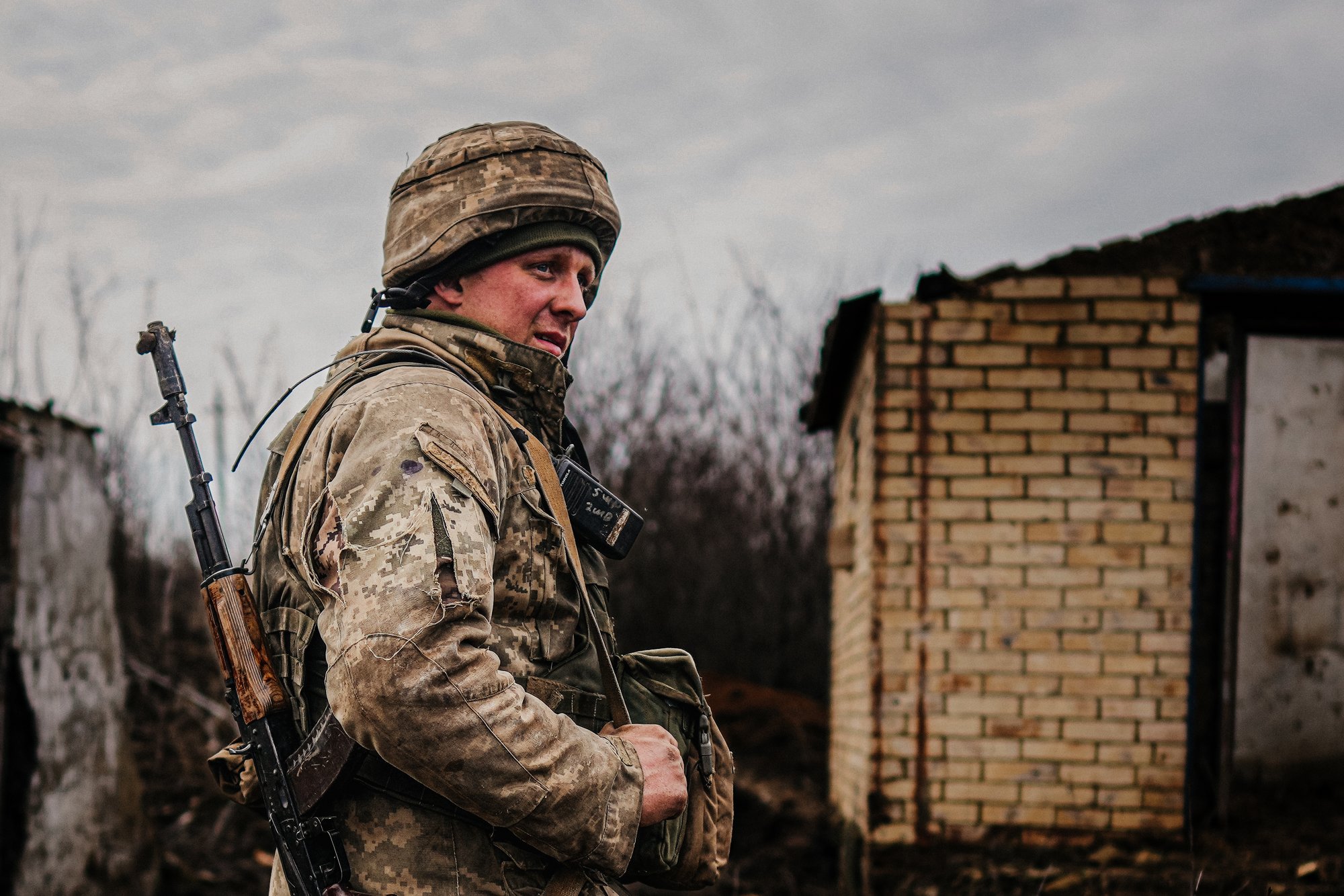
A Ukrainian serviceman stands at his position at the line of separation between Ukraine-held territory and rebel-held territory near Svitlodarsk, eastern Ukraine, Wednesday, Feb. 23, 2022. AP photo by Evgeniy Maloletka.
The following is a condensed version of a presentation delivered to the Joint Special Operations University at MacDill Air Force Base on March 23, 2023.
In those final weeks before Russia’s full-scale invasion, I spent a lot of time with Kyiv’s territorial defense forces, as well as other groups, like the Georgian National Legion, which were training civilian volunteers for combat.
I remember standing out there in those snowy fields on some brutally cold winter days, watching these civilians — men and women of all backgrounds, from teenagers to people in their sixties and seventies — as they ran through combat drills and trained to attack Russian tanks.
I kept thinking, Are they really gonna do it?
If Russia invaded, I wondered whether these everyday people would really have the courage to face the gunfire, the artillery, and the missiles — would they really have the courage to face all that, hold their ground, and fight back?
More than one year later, we have our answer.
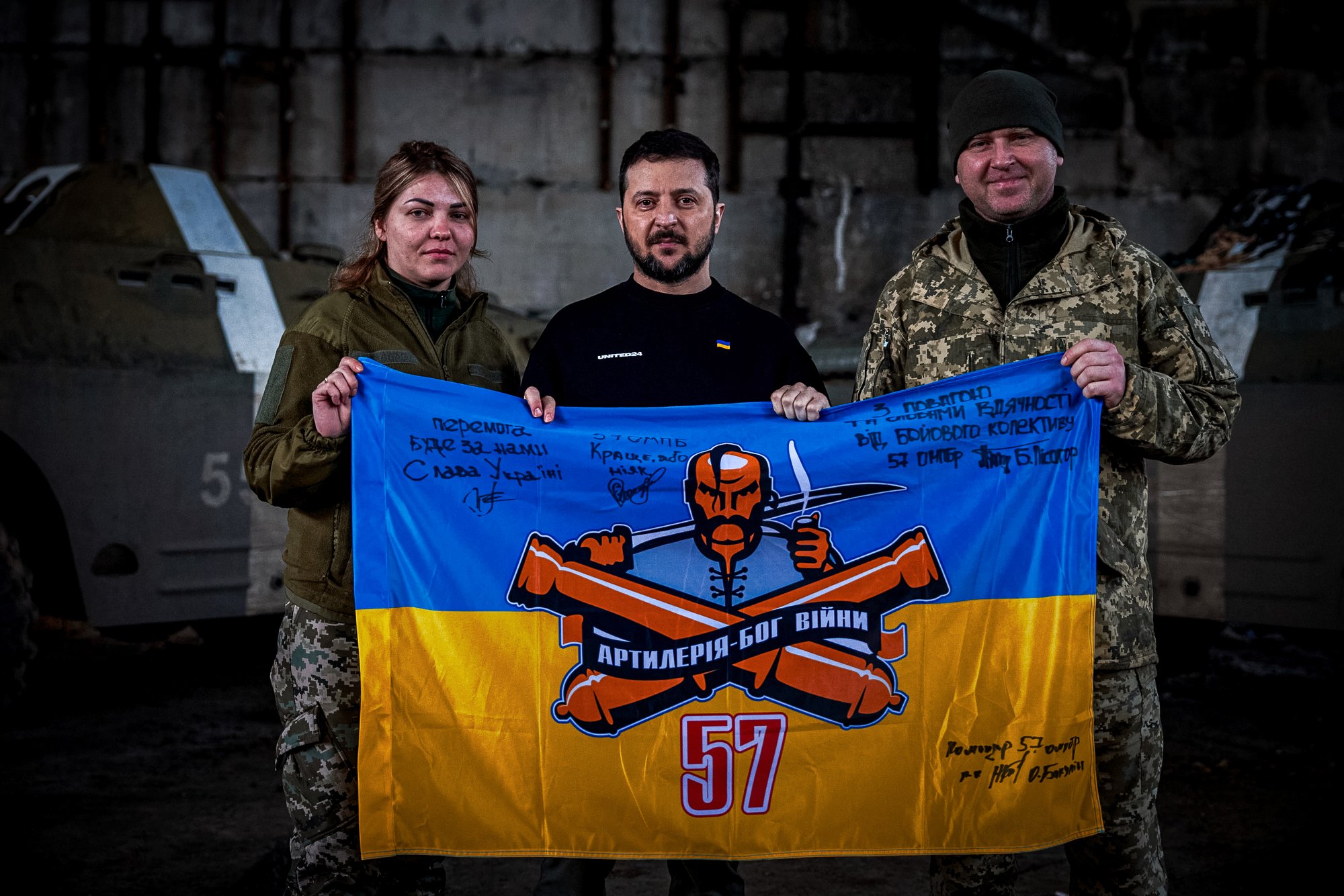
Ukrainian president Volodymyr Zelenskyy, center, and Ukrainian soldiers hold the flag of a military unit at a position near Bakhmut, Donetsk region, Ukraine, Wednesday, March 22, 2023. Ukrainian Presidential Press Office via AP.
As I pen these words, Kyiv remains the capital of a free and defiant country because Ukraine’s soldiers, civilians, and political leaders held their ground, turned the tide of battle, and saved their country.
This war is not yet over. But its opening chapter has ended. Everything that happens next will happen because Ukrainians — inspired by values that we all share — bootstrapped a fighting force that defied Russia and won the world’s respect.
I’d like to share some of my experiences from the nine years I’ve lived in Ukraine, reporting on this war since its inception in 2014. I’ll try my best to identify what I think are some important, big-picture lessons from Russia’s invasion and Ukraine’s resistance, which may help our country prepare for the next war.
Above all, I want to highlight what has, so far, been my top takeaway from this war and the one aspect of it that I think differs most strikingly from my own wartime service, and that is the invaluable role that civilian resilience and civilian grit have played in supporting Ukraine’s overall military effort to defend the homeland.
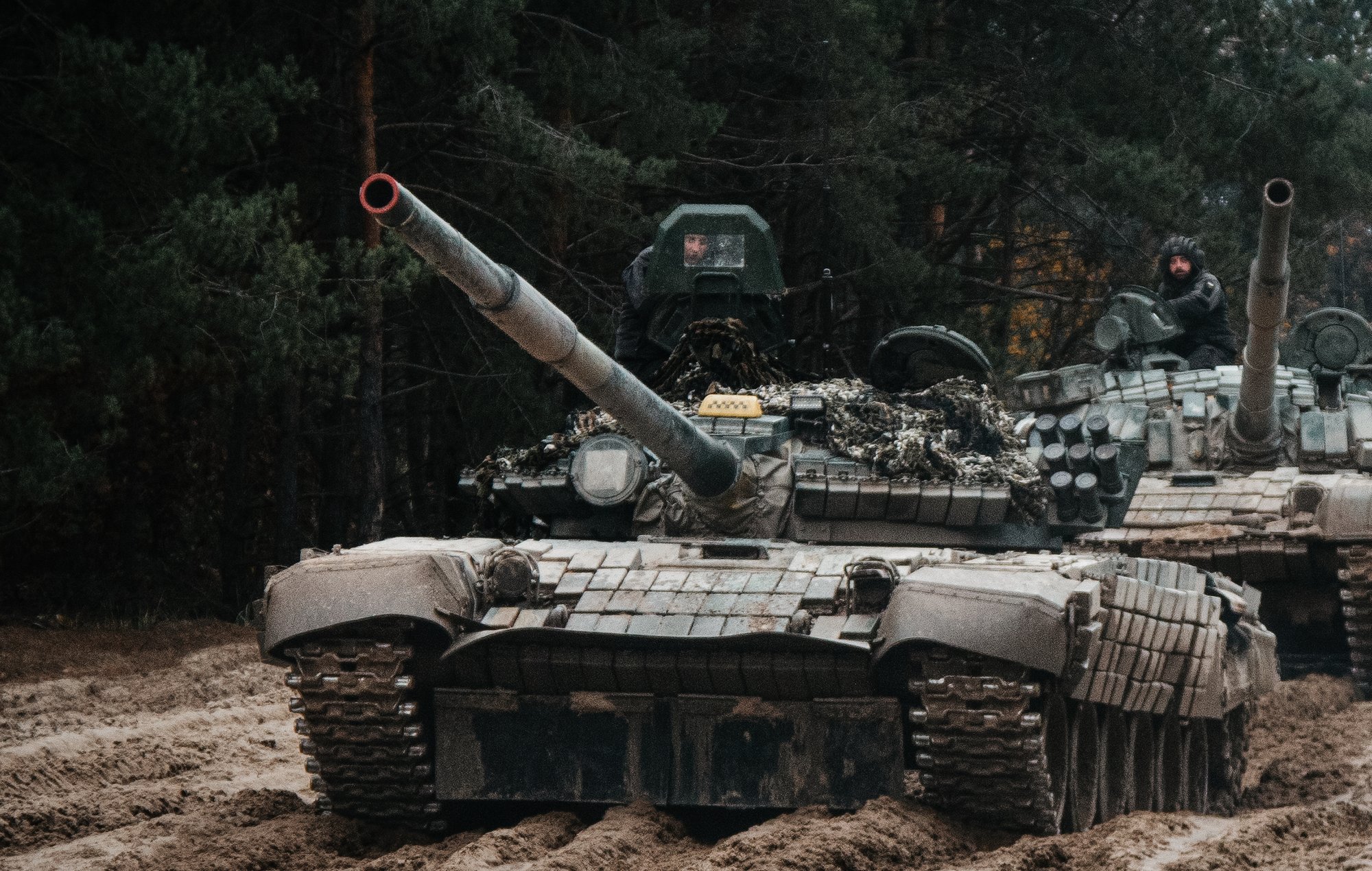
Ukrainian soldiers on captured Russian tanks T-72 hold military training close to the Ukraine-Belarus border near Chernihiv, Ukraine, Friday, Oct. 28, 2022. AP photo by Aleksandr Shulman, File.
During this past year, I’ve often thought of a quote from the movie Rocky Balboa. During one famous scene, Rocky says:
“It ain't about how hard you hit. It's about how hard you can get hit, and keep moving forward. How much you can take, and keep moving forward. That's how winning is done!”
As we, in the US, look ahead to a new era of warfare against much more capable adversaries, we need to learn from the Ukrainians, and to think about our country’s collective ability to get hit and still retain the will to fight back.
The Will to Fight
As we look ahead to 2023 — and what will surely be another tough year — it remains clear to me that Russia has no path toward achieving its political objectives in Ukraine. No matter what happens on the battlefield, the Ukrainian people will never submit. And each new Russian atrocity reinforces their resolve.
My friend, Denys Antipov, served in the Donbas in 2015 as a Ukrainian army lieutenant. Not long after he returned home, he told me this:
“Wars aren’t being won by surrendering. You have to fight. If you don’t fight, you won’t be supported by anyone. Because it’s your own freedom, and you have to fight for it.”
After serving in the Donbas, Denys went on to become a university instructor and a small business owner. He rejoined active duty immediately after the full-scale invasion and was wounded by artillery in March during a battle near Kharkiv. After just a few weeks in the hospital, Denys snuck out and rejoined his unit on the front line.
On May 11, 2022, a Russian artillery strike killed Denys. He was 32.
Ukrainians, like Denys, have the will to fight. They proved that nine years ago when protesters — including my wife, Lilly — braved sniper fire to overthrow their corrupt, pro-Russian president and to set their country on an irreversible path toward democracy and away from Russia.
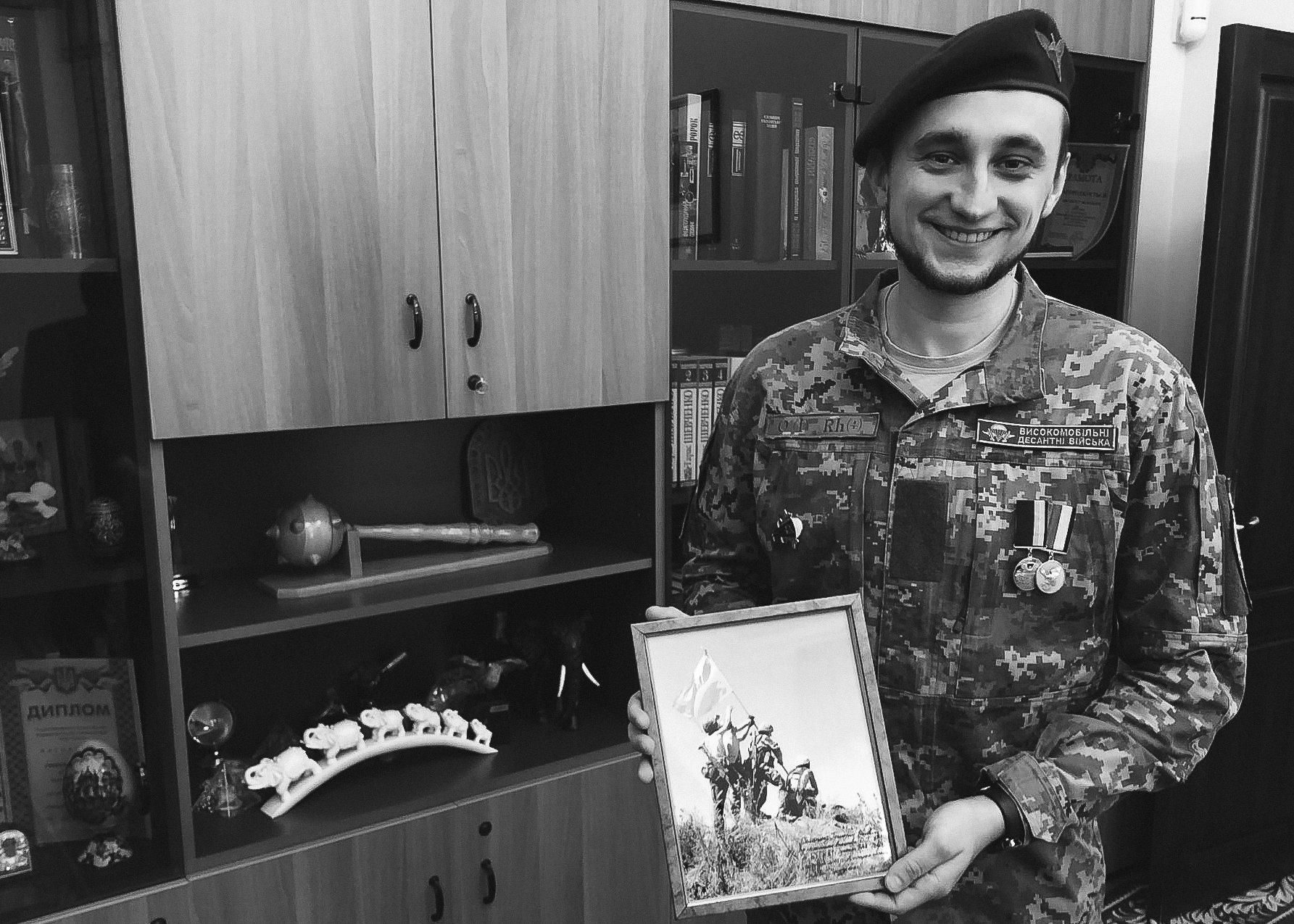
Denys Antipov presents a framed copy of his flag-raising photo to Taras Shevchenko National University of Kyiv in October 2018. Photo by Nolan Peterson/Coffee or Die.
In January 2022, a 63-year-old Kyiv resident named Ivan Peron told me this:
“Russia lives for the past, we live for the future, and it is a crucial difference between us. We do remember the USSR — standing in huge lines to get toilet paper, washing powder, soap, buckwheat. It was the Middle Ages. We want to be part of Europe, the West, we want to be in the civilized world. We want democracy to be in our country and to live by democratic rules.”
Ukraine’s 2014 Revolution of Dignity was a grassroots uprising, created and carried out by Ukrainians who wanted to live in a democracy and be free from Russian oppression. By invading Crimea and the Donbas in 2014, Russian President Vladimir Putin wanted to reverse the outcome of Ukraine’s pro-democratic revolution.
Nine years ago, Putin assumed the war would break Ukraine’s civil society and cause the country to unravel from within. Ukraine’s citizens proved to be much more resilient than Putin had anticipated, and by 2022, Putin likely felt that time was running out to reimpose Russia’s imperial rule over Ukraine. What he failed to realize, however, was that the point of no return had already passed years ago. Thus, Russia’s full-scale invasion this past year reflects an epic misunderstanding of Ukrainian society. Because of the full-scale war and all its brutality, Russia has forever lost whatever specks of influence it still retained in Ukraine.
For Ukraine’s millennials and its Generation Z, the Soviet Union is a second-hand memory. They grew up watching American movies and experiencing Western culture through social media and the internet. These young Ukrainians have a clear vision of the life they want to live and the future they want for their homeland — and that future includes a complete and permanent divorce from Russia.
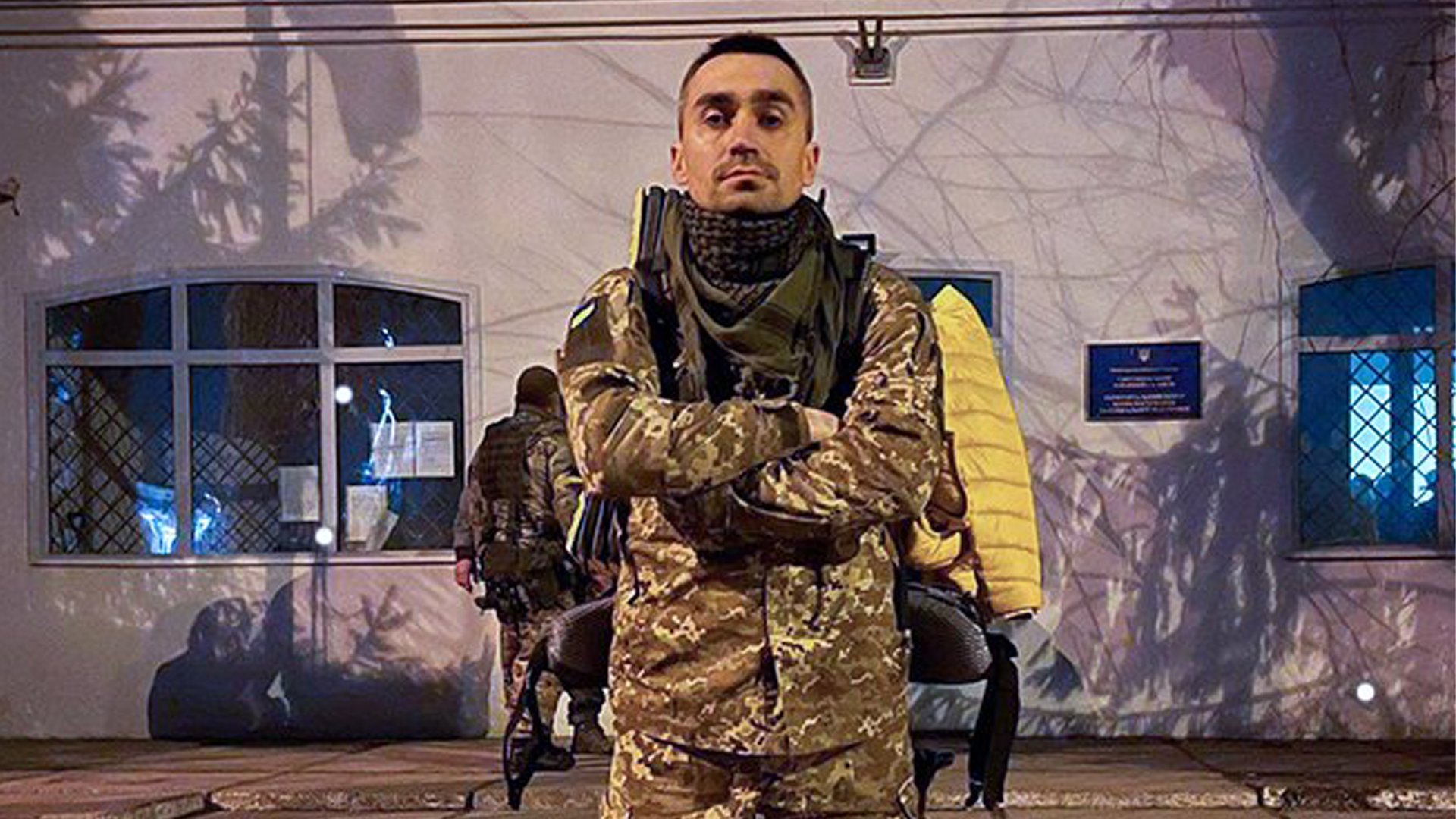
Oleksandr Makhov in his military uniform on Feb. 24, 2022, the first day of Russia’s full-scale invasion. Photo courtesy of Oleksandr Makhov.
It’s true that many Ukrainians have family ties to Russia and speak Russian at home. Yet during my nine years of reporting on the war, the overwhelming majority of volunteer soldiers that I’ve met on the front lines have been Russian-speaking Ukrainians, from the eastern part of the country, who saw firsthand how Russia invaded their hometowns in 2014.
My friend and fellow journalist Oleksandr Makhov fled his home in Luhansk in 2014 after the Russians invaded. He joined the Ukrainian army in 2015 and served in combat on the eastern front lines.
“When Russia stole my home in 2014, I felt like I didn’t deserve this. It was an injustice, it wasn’t fair,” Oleksandr told me.
After leaving the military, Oleksandr went back to work as a journalist. Yet, as a combat veteran, he belonged to Ukraine’s first operational reserve — the first wave of military reservists who would be recalled to active duty should Russia invade. Knowing he would have only 24 hours’ notice, Oleksandr prepared a “veterans suitcase,” including all his uniforms and the gear he’d need to immediately report for duty.
On Feb. 4, 2022, just a few weeks before the full-scale war, Oleksandr told me: “My war never ended — it’s just been on pause. I tell myself that if I have to go back, I will flip on a switch and be a soldier again.”
And that’s exactly what he did.
On Feb. 24, only hours after Russia’s full-scale invasion began, Oleksandr rejoined his former unit and deployed to the front lines. A few weeks later, using a grenade pin as an engagement ring, he proposed to his girlfriend, Anastasia, in a video message from the front lines.
After Oleksandr died in combat near Izyum over the summer, his bereaved fiancée then joined the Ukrainian army and is now serving on the front lines in his honor.
No Backing Down
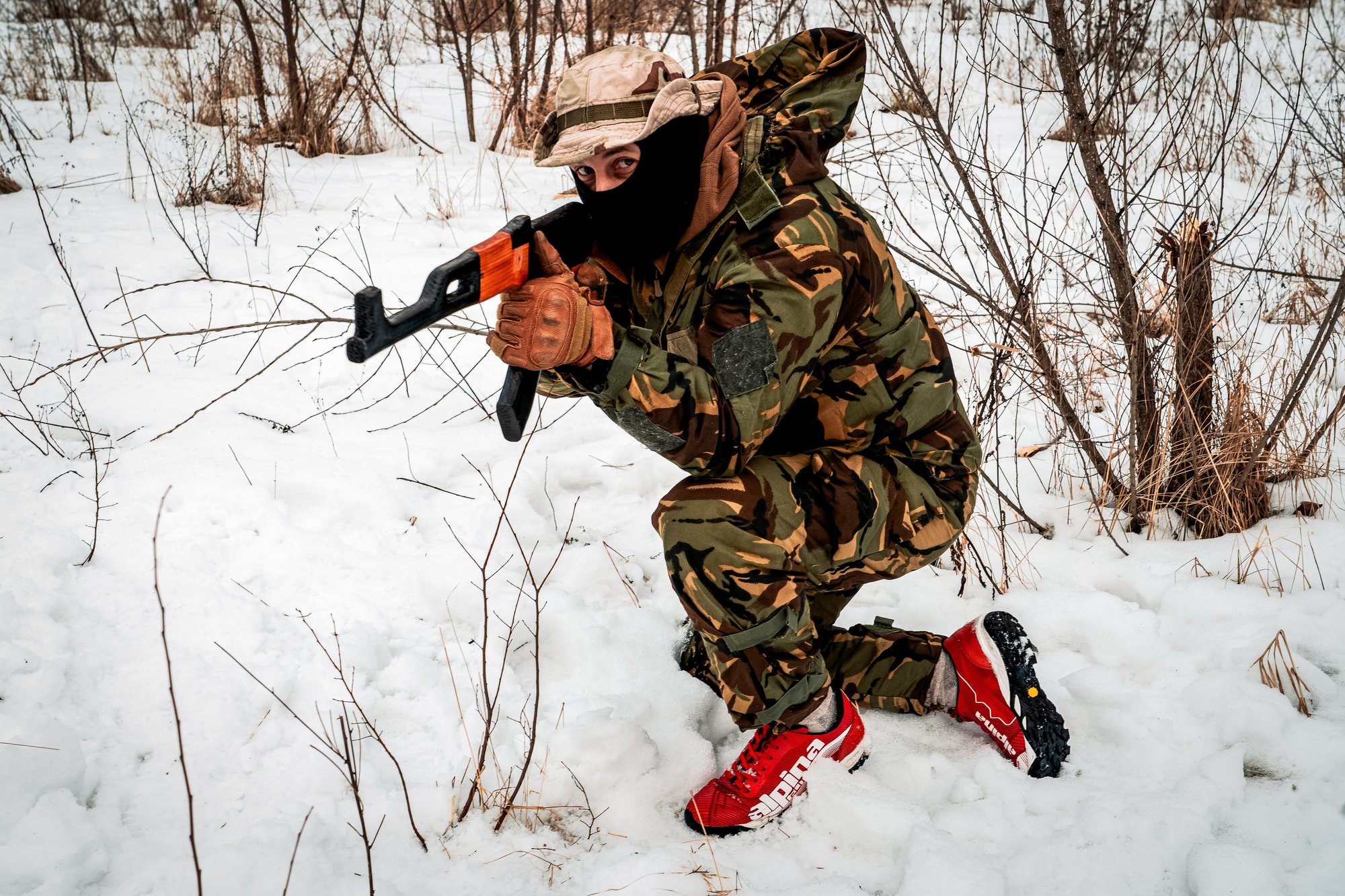
A civilian trainee participates in a military training course with the Georgian National Legion in Kyiv on Tuesday, Feb. 8, 2022. Photo by Nolan Peterson/Coffee or Die.
After successful counteroffensives in the south and east last year, Ukrainian forces have now taken back roughly half of the territory Russia invaded after Feb. 24, 2022. Frustrated by its unsuccessful ground war, Russia embarked on a strategic campaign of missile and drone strikes against civilian targets across Ukraine this winter. The intent was to terrorize civilians and knock out the national power and heating grids.
But Moscow’s plan failed.
Ukrainian workers continue to repair the damage faster than Russia can inflict it. Supported by the West, Ukraine’s air defenses are holding out. And, most importantly, civilian morale never cracked.
Despite the blackouts and the terror, Russia’s missile and drone strikes have hardened Ukrainians’ will to resist. These days, a popular saying is that Ukrainians would rather live without power and without heat than live with Russia.
The latest polling found that about 90% of Ukrainians are against making territorial concessions to Russia for the sake of ending the war. This attitude is uniform across Ukraine, with at least 80% of people in every region supporting the full de-occupation of all Ukrainian land — including Crimea and the eastern Donbas region. And that share keeps climbing as Russia continues to incriminate itself by targeting civilians and committing war crimes, including the 16,000 Ukrainian children who have been forcibly deported to Russia.
When it comes to victory, Ukrainians care about much more than lines on a map. They care about liberating millions of their fellow citizens who now live under Moscow’s brutal occupation. They want to stop the mass murders, the mass rapes, the plundering, the deliberate targeting of residential areas, and the annihilation of whole cities like Mariupol.
Genocide
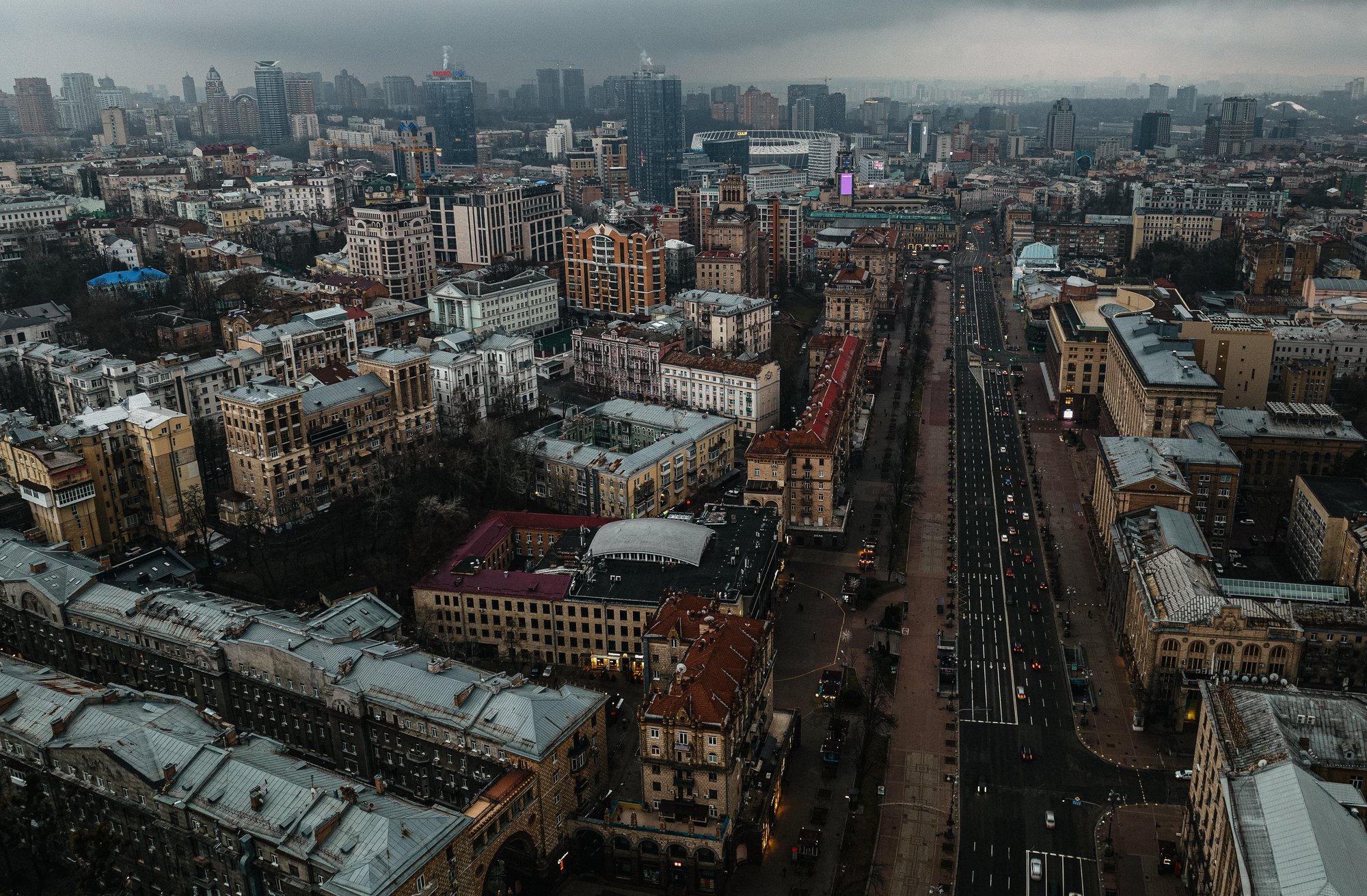
Cars move down a street in Kyiv, Ukraine, Thursday, Feb. 24, 2022. AP photo by Emilio Morenatti, File.
This past year has reminded us just how thin the veneer of civilization truly is — and how quickly things can fall apart. Those early morning hours of Feb. 24, 2022, were like a nightmare come true.
Putin declared his so-called “special military operation” in a televised address, and then, a little while later, cruise missile strikes thundered across Ukraine, while Russian ground forces invaded from multiple directions. I remember standing on a rooftop in Kyiv that morning. I looked out over a horizon of city lights and listened to the sounds of cruise missiles exploding and thought, How is this possible?
A European capital, under a full-scale attack by the armies of a madman bent on imperial conquest and genocide. In the span of one human lifetime since the end of World War II, we let it happen again.
When the sun rose that morning, millions of Ukrainians faced a hard choice: stay or flee? During those frightful first few days, the roads out of Kyiv clogged with traffic as millions evacuated. And thousands of people, with as much luggage as they could carry, trekked on the sidewalks toward the city’s main train station.
That train station soon became a chaotic scene, filled to the limit with people hoping to escape. At one point, I observed desperate mothers passing off their children to strangers aboard overloaded trains. They did whatever they could to get their kids out of Russia’s warpath.
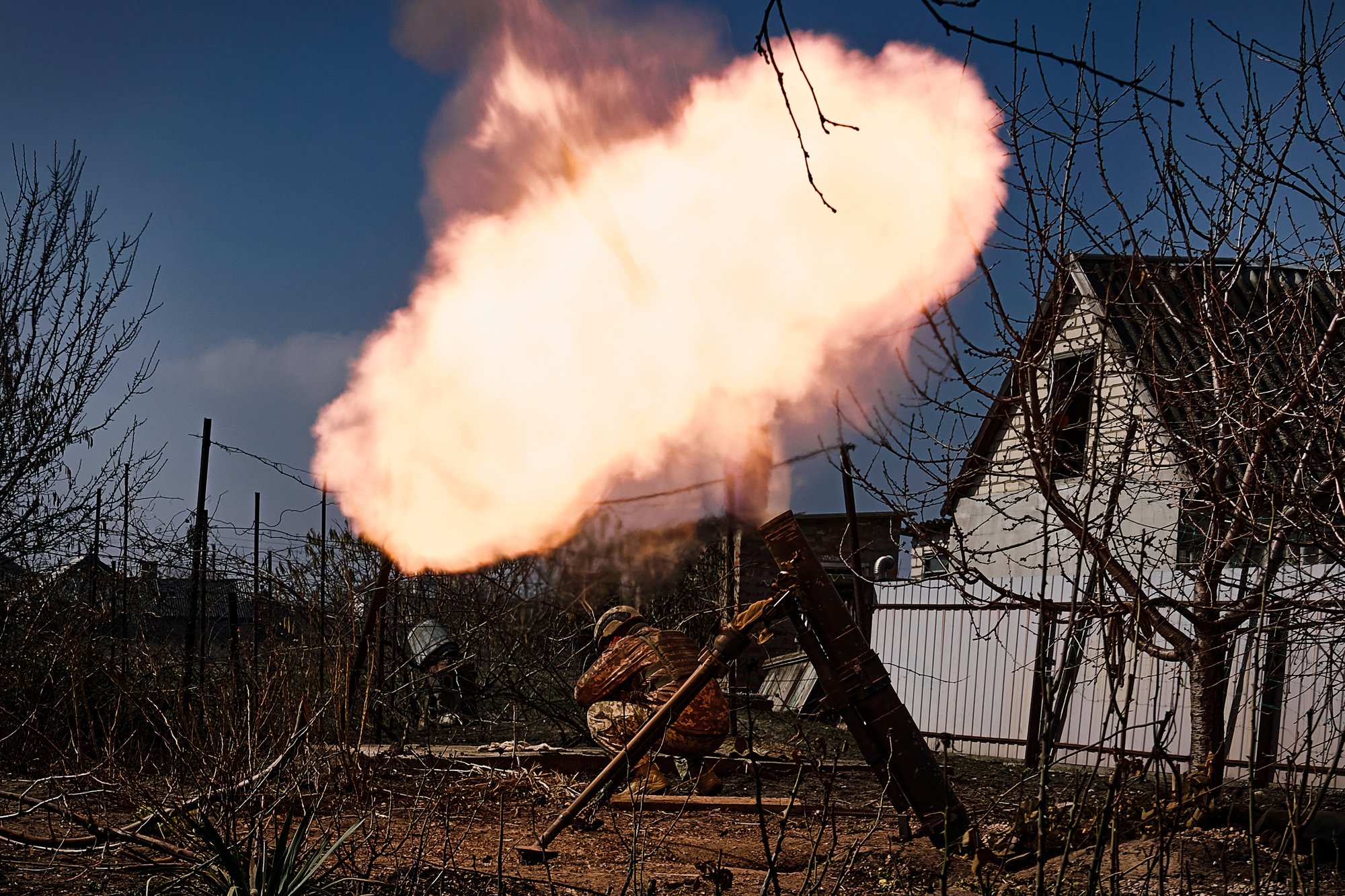
Ukrainian soldiers fire a mortar at Russian positions on the frontline near Bakhmut, Donetsk region, Ukraine, Sunday, March 26, 2023. AP photo by Libkos.
At first, it looked like Kyiv might fall.
On the morning of Feb. 25, the second day of the full-scale war, Russian soldiers had already pushed within the city limits. A gun battle erupted on the streets of the Obolon neighborhood, within earshot of my downtown apartment. At night, Ukrainian surface-to-air missiles and anti-aircraft tracers cut across the sky. And each time you heard jet noise overhead, you wondered, Is it Russian or Ukrainian?
Despite the danger, Kyiv’s citizens quickly adapted. Down in the bomb shelters, you’d see snapshots of their resilience and grit. There were smiles and laughter. Children playing. And, quite often, you’d hear one particular sound above the others. It came from people’s smartphones, as they listened, over and over again, to President Volodymyr Zelenskyy declaring that he would not leave the city.
Zelenskyy’s defiance inspired Ukraine’s soldiers and civilians to dig in and do whatever was necessary to save their country. On Feb. 25, Kyiv city officials distributed more than 18,000 weapons to volunteer defenders. And by March 6, some 100,000 Ukrainians had joined territorial defense units nationwide.
In the days that followed, lines stretched outside of military recruiting sites in Kyiv. So many people volunteered to fight that the army had to turn them away in droves. Even the monks at Kyiv’s St. Theodosius Monastery took up arms, fortified their church, and prepared to fight.
Despite this spirit of resistance, those first few weeks tried people’s souls. Russian missiles repeatedly struck residential areas, killing scores of civilians. We learned to live with the fact that there was no safe quarter within the city. Death could arrive at any moment, and at any place.
On Kyiv’s outskirts, Russian troops constantly attacked civilians fleeing in their personal vehicles, sometimes murdering entire families as they tried to escape. Journalists were targeted and murdered, too, including a well-known Ukrainian photographer named Maksym Levin, whose body was found in a forest outside of Kyiv on April 1.
The Russians had tortured and interrogated Maksym, and then executed him with two gunshots. He left behind a wife and four children.
After two weeks at war, some 2 million people, more than half of Kyiv’s pre-war population, had already evacuated. By then, an eerie quiet descended over the once bustling downtown streets. It was totally bizarre, like walking through the set of a zombie movie.
Stacked concrete blocks, anti-tank hedgehogs, and barbed wire went up around the city. Supply lines strained, and store shelves emptied. Each day, people waited in long lines outside of grocery stores and pharmacies. Martial law went into effect, and there was a nightly curfew. Troops on the streets were edgy and on guard for collaborators and spies. If they deemed you suspicious looking, they’d approach with guns drawn and demand your documents.
Each day, the sounds of battle edged closer and closer, and it seemed like things were going to fall apart. But they never did. The Ukrainian military stopped the Russian advance on the city’s outskirts, and Kyiv was never encircled or truly besieged. The southern roads remained open, allowing the flow of goods and supplies. On the battlefield, Ukrainian forces, armed with American Javelin anti-tank missiles and other Western weapons, wreaked havoc on the Russian invaders.
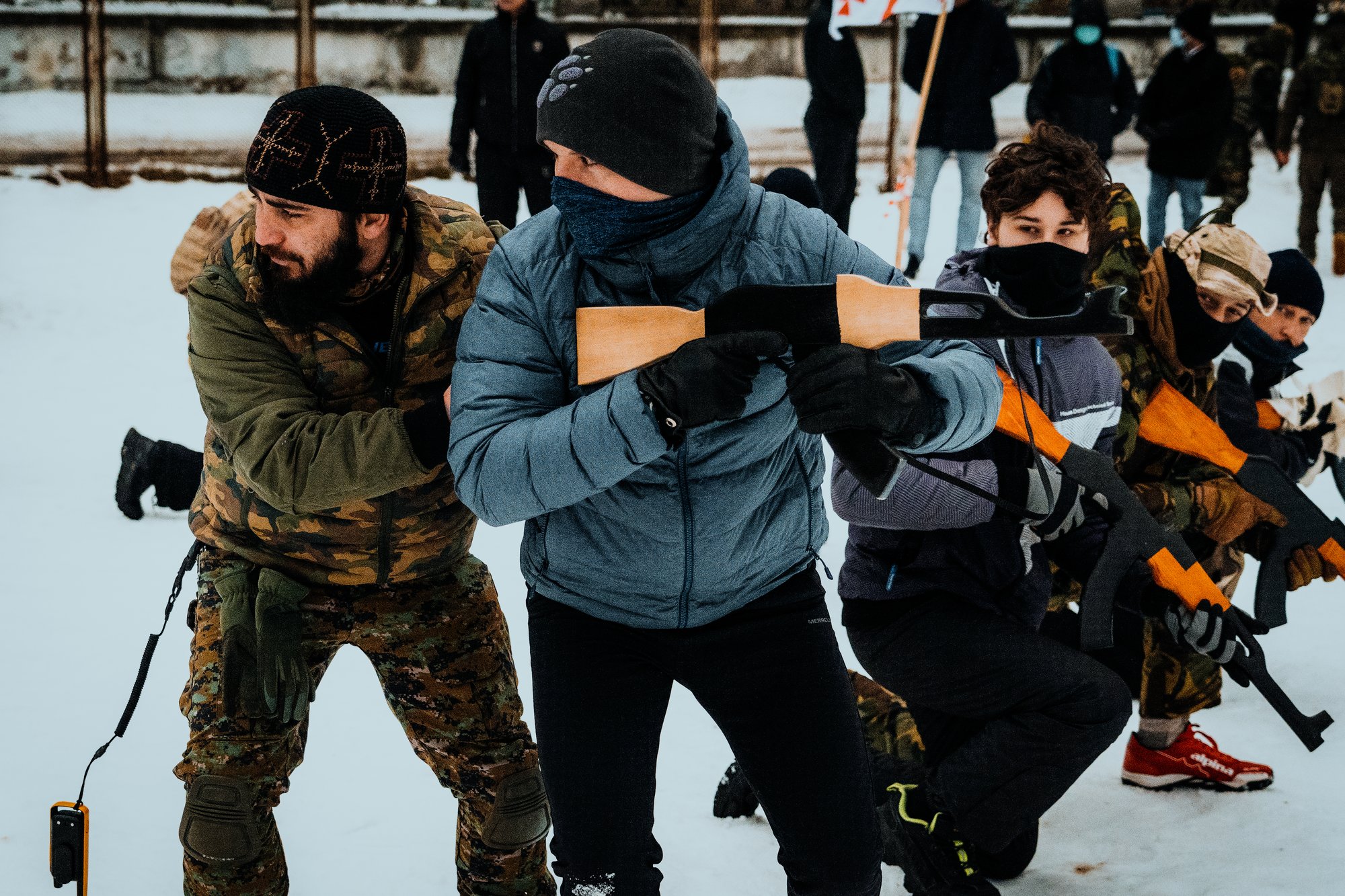
A civilian trainee participates in a military training course with the Georgian National Legion in Kyiv on Tuesday, Feb. 8, 2022. Photo by Nolan Peterson/Coffee or Die.
The Kremlin assumed it could take Kyiv and topple Zelenskyy’s government in just a few days. Yet, by April 1 — 37 days into the full-scale war — Russian forces fully retreated from Kyiv’s outskirts.
Around that time, I went for a walk along the Dnipro River and met a gray-haired woman sitting on a bench with her smiling face pointed toward the sun. I introduced myself and asked the woman, whose name was Liudmyla, how she felt now that Ukraine had won the Battle of Kyiv.
She told me: “I’m very proud of my country. We’ve been fighting for our freedom for more than a century, and I believe we will finally win it.”
After the Russian retreat, life carefully resumed in Kyiv. But on the city’s outskirts, the destruction was apocalyptic. Roads were clogged with burnt and blasted Russian tanks and the gruesome remains of many Russian soldiers. Whole neighborhoods and villages were pulverized and turned to rubble. Fields churned by artillery into lunar landscapes. And the carnage in places like Bucha and Irpin warned of Moscow’s dark and unfinished ambitions.
The dead bodies of civilians lined the streets. Some were shot in cold blood as they rode their bicycles. Some had their hands bound together, with bullet holes in the backs of their heads. Some were dumped in mass graves. Some were splayed out on the asphalt, frozen in the instant of their death.
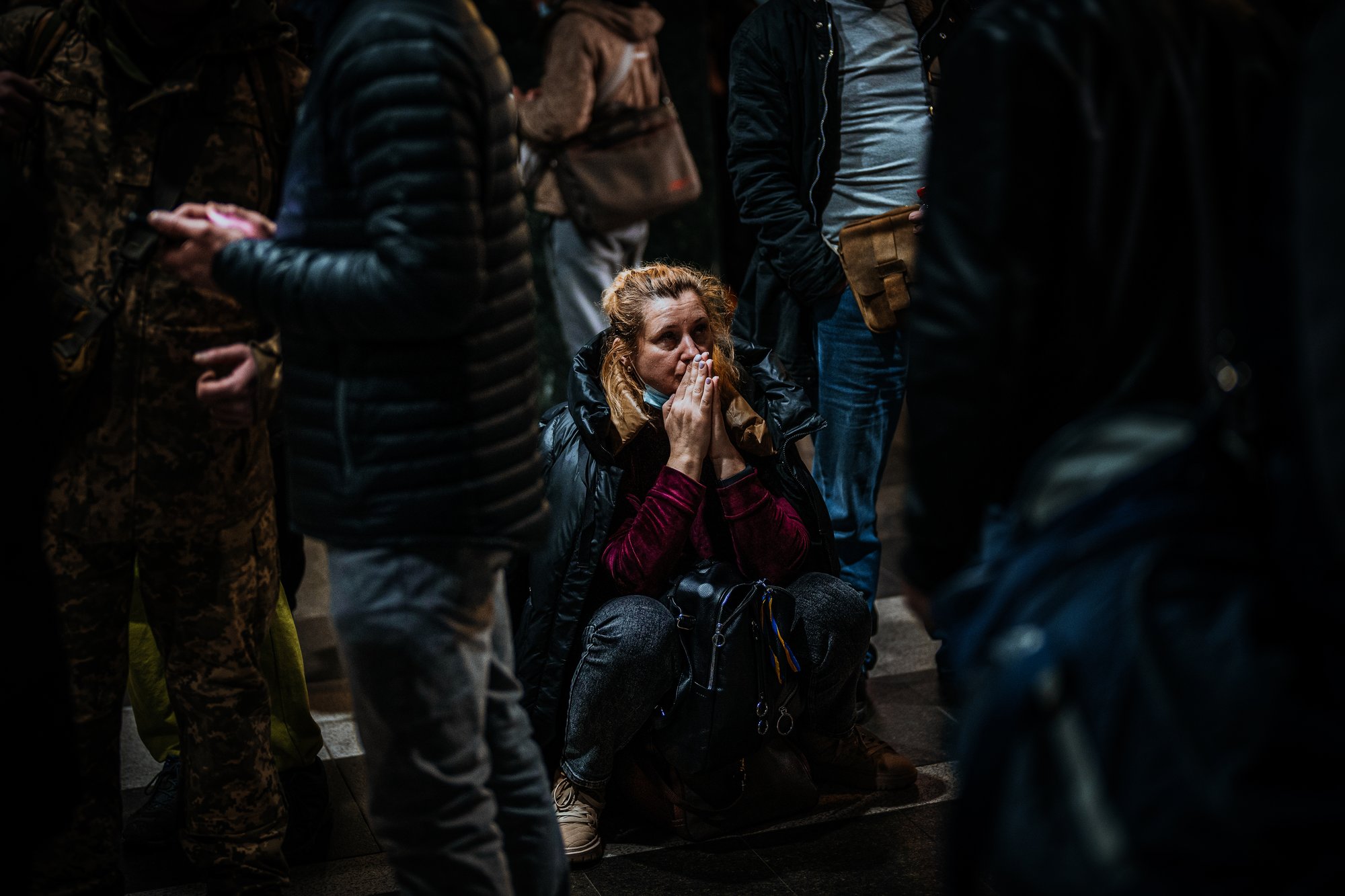
A woman reacts as she waits for a train trying to leave Kyiv, Ukraine, Thursday, Feb. 24, 2022. AP Photo by Emilio Morenatti.
This was genocide. Plain and simple.
After discovering what Russian troops had done in the places around Kyiv they’d briefly occupied, Ukrainians understood they were no longer fighting for their freedom. They were fighting for their survival. And it’s hard to fathom making any concessions to an enemy that is committing genocide against your own people.
Transformation
Looking back, it’s clear that the 2014 Revolution of Dignity, and the ensuing eight years of limited warfare in the Donbas, turbocharged all the changes that Ukraine needed to make in order to survive this past year. Things like Ukraine’s spirit of innovation, independent thinking, and entrepreneurship. These qualities transformed civil society, as well as the military, giving soldiers the freedom to innovate new tactics and technologies and to have the flexible mindsets needed to rapidly field a mix of Western weapons.
When Russia invaded in 2014, Ukraine’s regular army was depleted by decades of post-Soviet corruption and could muster no more than a few thousand combat-ready soldiers. With Ukraine’s regular army on its heels, a nationwide, grassroots resistance movement took shape. Known as the “volunteer battalions,” these irregular units generally comprised men and women with little or no military experience, including native Russian and Ukrainian speakers from all regions of Ukraine.
Volunteers learned how to be soldiers while in combat, a baptism by fire they jokingly referred to as “natural selection” boot camp. It was a grassroots war effort, underscoring a widespread attitude of self-reliance among Ukrainian citizens who were unwilling to wait for the government to save them in a moment of crisis.
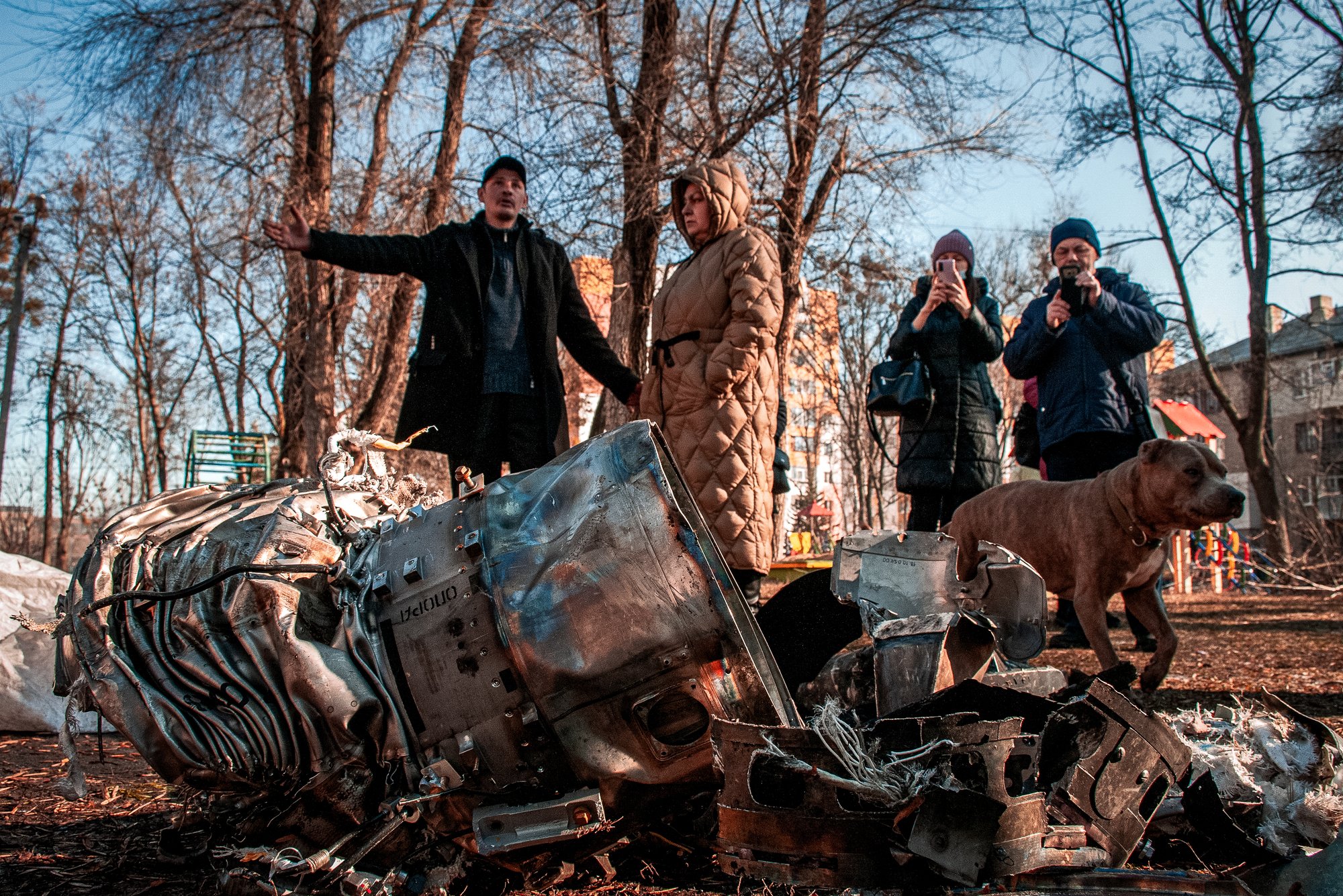
People stand next to fragments of military equipment on the street in the aftermath of an apparent Russian strike in Kharkiv, Ukraine, Thursday, Feb. 24, 2022. AP photo by Andrew Marienko.
Ukraine’s makeshift military — the “Bad News Bears of War,” as I called them back then — fought the Russians to an entrenched stalemate that persisted until February 2022. Over the intervening years, I visited those front lines in the Donbas many times. It was always so bizarre to observe the two sides entrenched within shouting distance of each other.
In the front-line town of Shyrokyne in 2015, I was on hand when drunk Russian soldiers crawled up to the Ukrainian lines at night and challenged them to single combat — one-on-one fistfights to the death, like ancient gladiators or something. At one front-line position near Avdiivka in 2021, no man’s land was only 50 meters wide. The Ukrainians spoke in whispers so as not to invite gunfire. They attached electric heaters to mannequins, creating decoys to fool any Russian snipers using thermal scopes.
There was clearly no love lost between the two sides. For their part, the Ukrainians believed that if they just packed up and left their trenches, the Russians would invade behind them all the way to Kyiv. And yet, despite the constant combat, Ukraine’s military underwent a radical, top-to-bottom transformation in the years after 2014. Most importantly, Ukrainian commanders began to ditch the rigid, Soviet-style chain of command in favor of the Western model of Mission Command, which pushes tactical decision-making down to front-line personnel.
Prior to the full-scale invasion, I asked Lt. Gen. Oleksandr Pavliuk, who was then the commander of Ukraine’s Joint Forces Operation in the east, to explain how Ukraine’s chain of command had changed.
“During the Soviet Union, the standard was mindless subordination to the chain of command," he told me. “In contrast, we now have trust in every commander, with much less direct oversight compared with the Soviet chain of command rules. Every commander trusts his subordinates. And [combat operations] are most effective when each commander understands his responsibilities and makes decisions independently, with respect to the situation at hand.”
Those changes paid huge dividends this year, allowing Ukraine’s combat leaders to make their own decisions based on battlefield realities rather than taking play-by-play orders from some faraway commander, as the Russians still do.
Ukrainian pilots also relied on their creativity and courage to stay in the fight, despite their technological and numerical disadvantages. After the Russians destroyed many of the Ukrainians’ ground-based navigation aids, the Ukrainian pilots improvised ad hoc solutions to navigate their aircraft. One MiG-29 fighter pilot told me he sometimes flew combat missions using a handheld Garmin GPS unit — the same kind you might use on a cross-country road trip. His fellow pilots flew so low to stay under the Russians’ radars that they sometimes returned with street signs embedded in their air intakes.
To escape Russian missiles in between missions, the Ukrainian air force used makeshift runways and bases. And yet they stayed in the fight, and to this day, the Russian air force has never achieved anything close to air superiority over all of Ukraine.
One Ukrainian MiG-29 pilot, whose callsign is “Juice,” told me:
“Maybe it’s stupid, but we don’t give a shit about technologies — we’re just trying to do everything with what we’ve got. It’s our land, it’s our families, it’s our cities. We are defending them. That’s the main motivation for us. And we succeed in this because the Russians are surprised. They are fucking surprised … Because they were not expecting resistance in the air at all.”
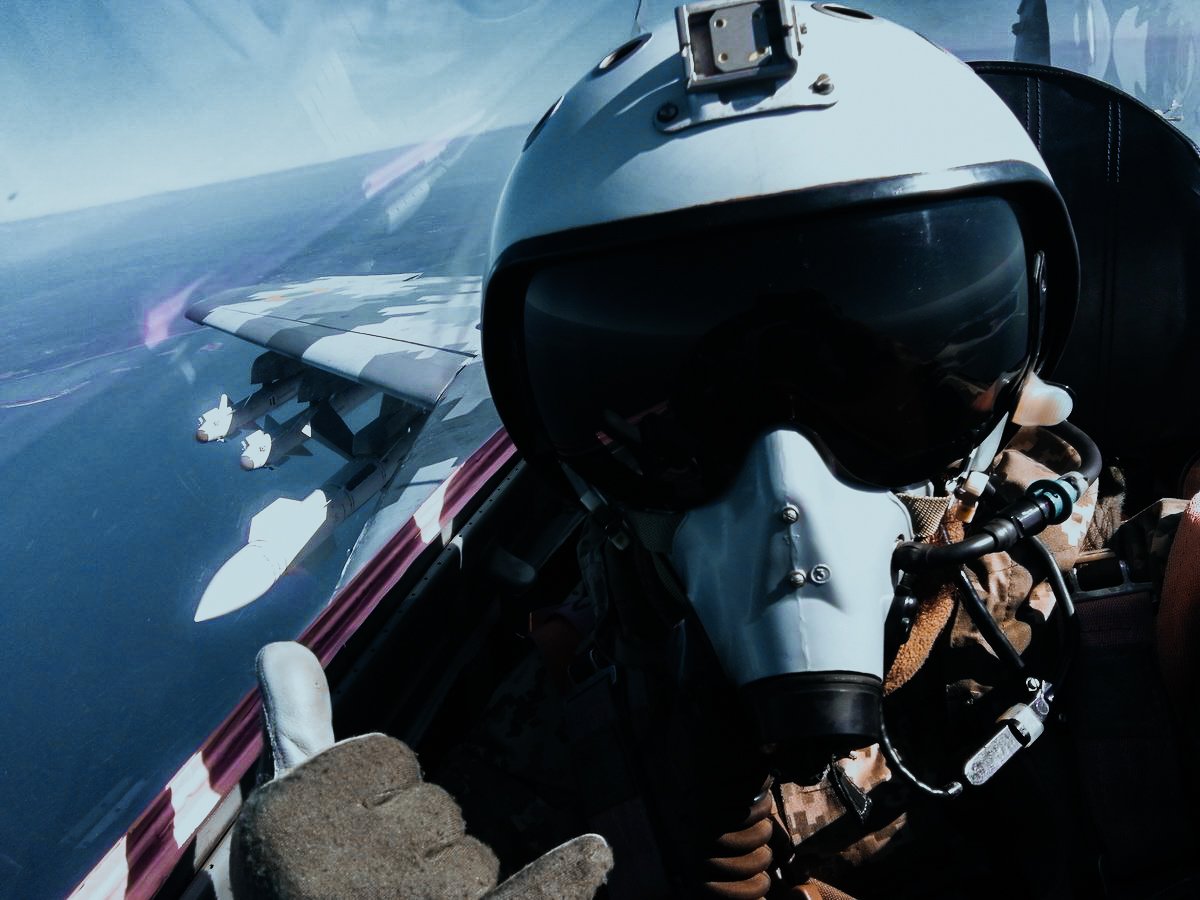
Juice, pictured in the cockpit of a Ukrainian MiG-29 fighter jet, spoke exclusively to Coffee or Die in March 2022. Photo courtesy of Juice/Ukrainian Air Force.
For its part, the Russian air force appears to have been complacent after years of flying in the uncontested airspace over Syria. And that complacency likely contributed to their underestimation of Ukraine’s air force. Similarly, many Ukrainian veterans of the Battle of Kyiv have told me that, in their minds, the Russians they faced were not psychologically prepared for the harsh realities of combat.
Some Russian units didn’t even know they were going to war until the last minute. Some Russian units brought along parade uniforms, expecting a triumphant march down Kyiv’s Khreshchatyk Boulevard after a few easy days of combat. Yet Moscow’s initial invasion plan fell apart after it encountered a ferocious adversary who was dug in and fighting smart.
Ukraine’s combat veterans were particularly instrumental in those early days of the war. Many rejoined the regular army. Others served in territorial defense units or spearheaded volunteer operations. Many veteran combat pilots also rejoined their former units and quickly regained proficiency in their warplanes while flying combat missions.
Prior to the full-scale invasion, Ukraine had more than 400,000 combat veterans of the war in the Donbas. That pool of manpower comprised the country’s first group of reservists, known as Operational Reserve-1, who were rapidly mobilized and integrated into active combat units.
Among their comrades, mobilized Ukrainian veterans were nicknamed the “dinosaurs.” Not only were they proficient soldiers, but those veterans — especially those who served in 2014 and 2015 — also played the invaluable role of mentoring newer troops who had never faced lethal danger or experienced the chaos of combat.

Emergency personnel work at the scene following a drone attack in Rzhyshchiv, Kyiv region, Ukraine, Wednesday, March 22, 2023. AP photo by Efrem Lukatsky.
Many of the volunteer soldiers I’ve interviewed this past year, most of whom had little or no military experience before the full-scale war, credited their survival to the lessons and the examples handed down to them by combat veterans of the Donbas. Across the spectrum of Ukraine’s armed forces, the positive impact of all that practical knowledge passed on by the dinosaurs far exceeded what a new recruit might learn in basic training.
The trench war in the Donbas served as a prelude to many of the headline-grabbing trends of the full-scale war. Those eight years spurred many of the innovations we’ve seen from the Ukrainians this past year. The use of small drones, for example. As far back as the summer of 2014, I observed Ukrainian units jury-rigging commercial, off-the-shelf drones for use in ISR, as well as for dropping small munitions on their enemies.
The Russians also adapted the use of small drones for reconnaissance and dropping weapons years before the full-scale invasion. Consequently, the Ukrainians became significantly more “drone conscious.” They avoided gathering outside, especially in clear weather, and they camouflaged their trenches and dugouts from aerial reconnaissance. During winter, after the leaves fell and there was less natural concealment, Ukrainian troops paid particular attention to concealing their movements and positions.
At a front-line post near Luhansk in 2021, a Ukrainian lieutenant named Illia told me, “It puts you under constant pressure when you always expect something from the air. You can never relax.”
Being out there, under that constant threat, made me reflect on my own military deployments to Iraq and Afghanistan, where we had relatively safe places to relax and decompress between missions. That’s a luxury the Ukrainians do not enjoy — even when they are back home with their families in places like Kyiv and Kharkiv.

Oleg, 13, holds a training weapon at a military training course with the Georgian National Legion in Kyiv on Tuesday, Feb. 8, 2022. Photo by Nolan Peterson/Coffee or Die.
The conflict from 2014 to 2022 also taught Ukrainians invaluable lessons in the perils of Russia’s electronic warfare threats. Many Ukrainian units conceal their electromagnetic emissions the same way they camouflage their physical presence on the battlefield.
In my opinion, the electronic warfare environment is one of the most underreported aspects of the war. Before the invasion, I stocked up on satellite phones and radios and solar panel charges and all sorts of stuff, thinking that Russian EW systems and cyberattacks were basically going to send Ukraine back to the Stone Age, as far as communications and internet connectivity.
That sort of urban blackout never happened. But on the front lines, GPS jamming and signals interference play a key role in the conflict. On the front lines, Ukrainians are constantly on guard against not clustering their electromagnetic emissions. Basically, every time they flip on a piece of electronic equipment or transmit a signal, they accept the fact that they have exposed themselves to the Russians.
Ukrainian critical infrastructure sites and important political and military sites are generally defended by GPS-jamming units meant to interfere with inbound Russian missiles and Shahed drones. But that defensive jamming can sometimes have a collateral interference effect on some air defense systems and other technologies that the Ukrainians are using to defend against those inbound threats.
On Ukraine’s front lines, you can’t always depend on GPS or constant communications. When all your high-tech tools stop working, you have to be ready to adapt workaround solutions. Again, as a veteran of Iraq and Afghanistan, I have to say that that constant feeling of exposure and that constant need to conceal your presence, both visually and electronically, is a very alien state of mind.
And, after a while, it gets exhausting.
Civil Resilience
For eight years, places like Kyiv remained quarantined from the physical effects of daily combat hundreds of miles away in the eastern Donbas region. The war was always there, but outside the war zone, life went on basically as normal.
The war was an abstraction for most Ukrainians, a series of sad news stories that they were able to tune out as they went about their daily routines. Consequently, the war became an unequally shared burden within Ukrainian society. Soldiers returning home from combat often felt isolated and out of place. As a veteran of Iraq and Afghanistan, that disconnect felt very familiar to me.
But the full-scale war changed all that.
No corner of Ukraine is currently spared from Russia’s invasion, and it’s an all-hands-on-deck effort to defend the homeland. The spirit of volunteerism among Ukraine’s civilians, which saved their country from disaster in 2014, kicked into overdrive when the full-scale war began. Literally overnight, Ukraine’s civil society mobilized to support the war effort.
Local defense forces rapidly fortified the entire country and built checkpoints around every settlement — from Kyiv to the smallest village. Along the main roads, militias stacked tires to be set ablaze as smokescreens against Russian forces. Volunteers took down road signs with the names of villages and towns in order to confuse the advancing Russians.
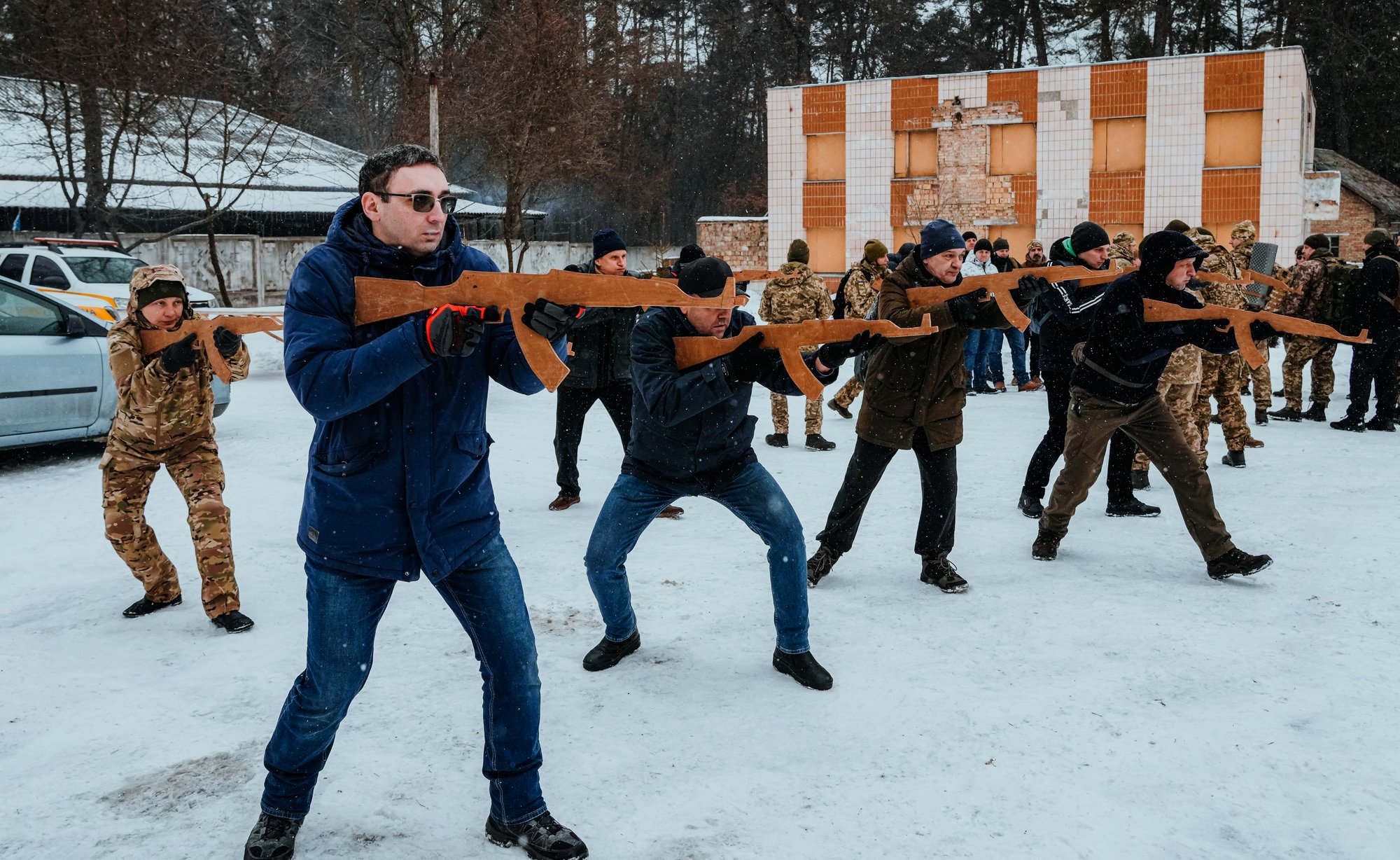
Members of Ukraine's Territorial Defense Forces, volunteer military units of the Armed Forces, train close to Kyiv, Ukraine, Saturday, Feb. 5, 2022. Hundreds of civilians joined Ukraine's army reserves in the weeks leading up to the Russian invasion. AP photo by Efrem Lukatsky.
In my wife’s hometown of Horishni Plavni, the war galvanized the city’s population. No one wanted to sit idle — they felt compelled to do whatever they could to support the war effort. Volunteers gathered food for soldiers and refugees at the local library. In the local performing arts hall, where Lilly used to dance ballet, hundreds of people of all ages worked day and night to sew camouflage netting for soldiers on the front lines. When parting ways, people started saying things like “everything will be okay” or “until victory” rather than offering a simple goodbye.
For an outsider, it was striking to witness. The Russian army was bearing down on this place, and yet rather than submit to fear or focus on personal priorities, these Ukrainians volunteered to help their community and their army.
Olena Dudko, the director of Horishni Plavni’s library, told me: “I’m extremely proud of our nation, and I know it’s impossible for Russia to defeat us. This is our land, and we will stand our ground.”
Across the country, Ukrainians were similarly able to instantly adapt to wartime life without their society unraveling. And after more than one year of full-scale warfare, Ukrainians are now more united than they ever were during the past three decades of post-Soviet independence.
Part of that society-resistance effort was due to planning by the Ukrainian government. In May 2021, Ukraine’s parliament adopted a new law, titled: “On the Fundamentals of National Resistance.” This law, which fully went into effect in January 2022, enshrined civilian resistance as a key component of Ukraine’s national defense against a Russian invasion.
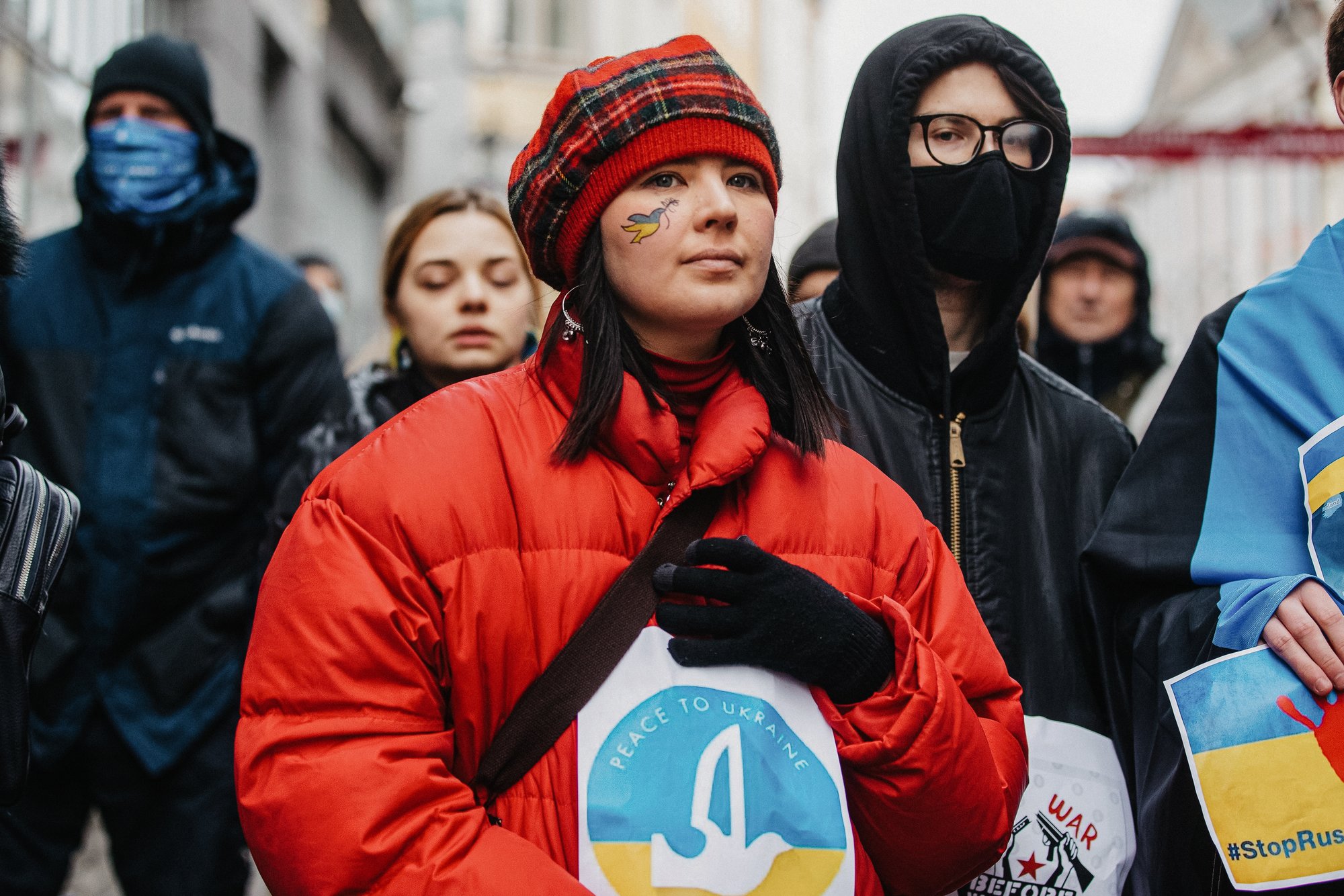
People, including Ukrainians, take part in a demonstration in support of Ukraine outside the Russian Embassy in Tallinn, Estonia, Thursday, Feb. 24, 2022. AP photo by Raul Mee.
Based on the “comprehensive defense” systems in NATO countries such as Estonia, Latvia, and Lithuania, Ukraine’s national resistance concept was built around three pillars — Territorial Defense Forces, mobilized civilians in irregular resistance units, and military training for the civilian population.
For their part, Territorial Defense units played key roles in saving Kyiv, Chernihiv, Sumy, and Kharkiv. And Ukraine’s resistance units, operating under Special Forces Command, also proved valuable in the early days of the full-scale war. Mobilized civilian partisans provided intelligence about enemy locations, and they took part in sabotage operations. In my wife’s hometown, which was never occupied, National Resistance Movement force partisans stockpiled weapons and Molotov cocktails, and they patrolled for Russian collaborators passing on intelligence for Russian missile and drone strikes.
After the invasion, Ukrainian SOF launched the National Resistance Center website to support the partisan movement. The website offers tips on guerrilla warfare and provides a way to anonymously report Russian military locations. The National Resistance Center’s slogan is: “Each one of us can resist the enemy and do his part for victory. Together, we will turn the enemies’ lives into hell.”
Over the past year, National Resistance Movement partisans developed into an effective irregular force. They do both kinetic and non-kinetic operations — including protests and the assassinations of pro-Russian collaborators and Russian occupation authorities. They also harass Russian troops in occupied areas, drawing resources away from front-line fighting.
While the National Resistance Movement is a relatively new concept, Ukraine’s nationwide network of Territorial Defense Forces was not a new idea in 2022. Most of these units formed in the immediate wake of Russia’s 2014 invasion. Their original purpose was to act as an operational reserve for the regular armed forces and to defend their local areas.
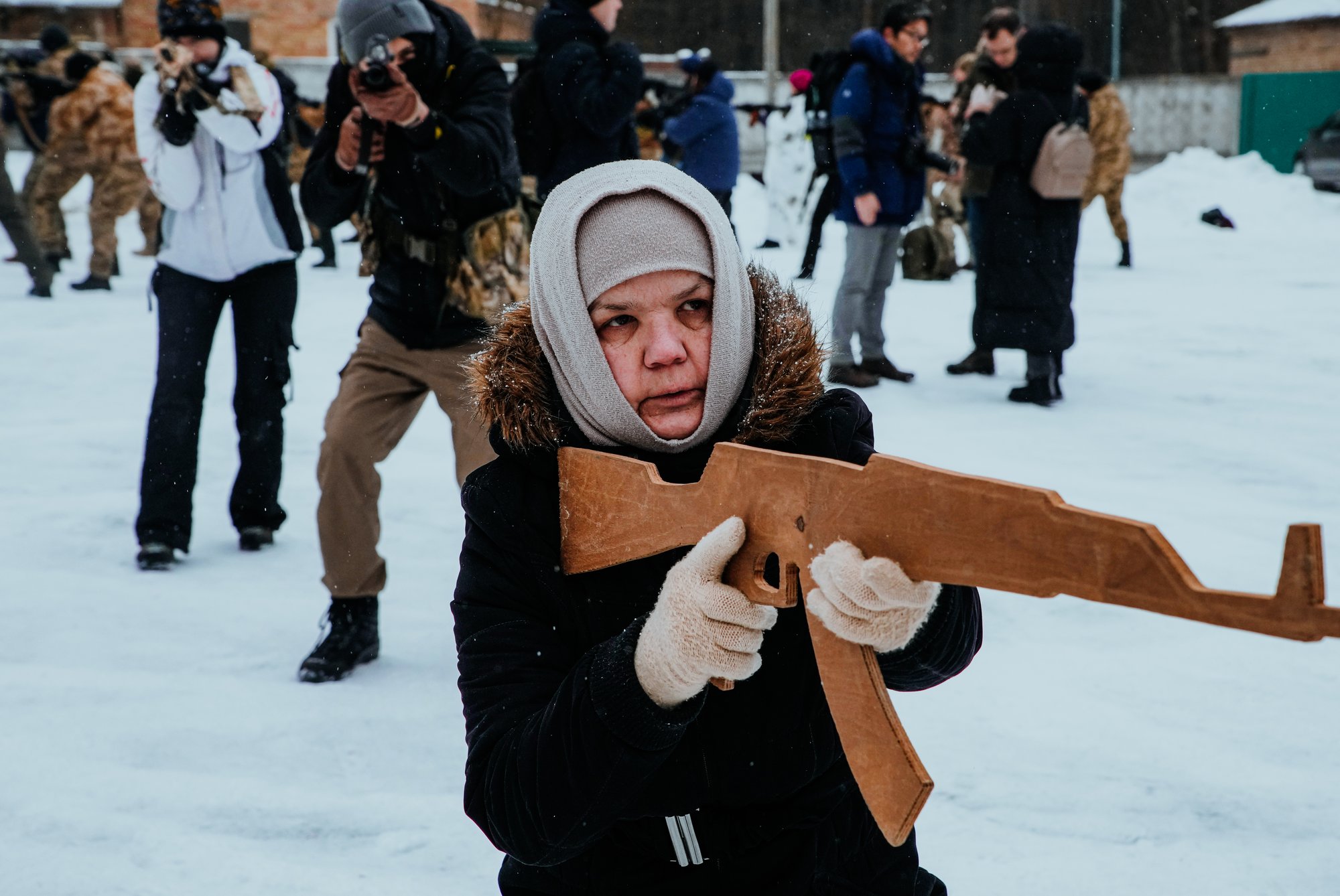
Rumia, 59, a member of Ukraine's Territorial Defense Forces, trains close to Kyiv, Ukraine, Saturday, Feb. 5, 2022. AP photo by Efrem Lukatsky, File.
These were not weekend warriors or wannabe soldiers. These were civilians who saw it as their duty to defend their families, their neighborhoods, and their homeland.
Although Ukraine’s territorial defense units fall under the regular military’s chain of command, each Ukrainian region, or “oblast,” is responsible for standing up its own territorial defense brigade. During the full-scale war, territorial defense troops have generally performed fundamental tasks — such as manning checkpoints or defending fixed positions — thereby freeing up regular army personnel for more skills-intensive, dynamic operations.
Attrition
In the summer of 2015, I embedded with the Ukrainian army in the front-line town of Pisky. While I was there, I befriended a 53-year-old soldier named Vasiliy Ivaskiv. A coal miner, Vasiliy called me “America,” and he had a habit of using his body to shield me from sniper fire during the eight days I spent embedded with his unit. He may have been older than most soldiers, but Vasiliy was built from steel, and he outlasted men less than half his age on daylong patrols.
When he first volunteered for war in 2015, Vasiliy said his wife collapsed in the doorway. Sobbing, she begged him not to go.
“There was nothing she could do to stop me,” he explained. “I had to go. It was my duty.”
When the full-scale war began last February, Vasiliy — who was by then 60 years old — returned to active duty. He died in combat near Izyum on Aug. 24, 2022.
Ukraine lost many of its most experienced soldiers in the first year of the war.
As the war drags on, and as attritional battles like Bakhmut continue to take their toll, Ukraine’s ranks have thinned of soldiers with combat experience prior to 2022, as well as those who participated in Western training programs, like the US-led mission at Yavoriv in Western Ukraine.
Combat attrition has forced the Ukrainian military to mobilize thousands of new recruits under the national draft. Under the current law, all physically fit Ukrainian men aged 18 to 60 are subject to conscription. My 57-year-old father-in-law, a Soviet army veteran of the Afghanistan era, falls into the group, and he’s currently assisting his city’s territorial defense force.
During the first few months of 2023, Ukraine has stepped up its national mobilization activities, and Ukrainian lawmakers are also trying to close loopholes for draft dodgers. This increased enforcement of the draft likely reflects the heavy toll of attritional battles, such as in Bakhmut.
According to some Ukrainian commanders, many of these new recruits lack sufficient training and are not psychologically prepared for the intensity of full-scale, conventional warfare. Thus, as the experience level and proficiency of the average Ukrainian soldier drops, there’s a risk that Ukraine’s forces could lose some of that flexibility and adaptability that gave them a qualitative edge over the Russians at the war’s outset.
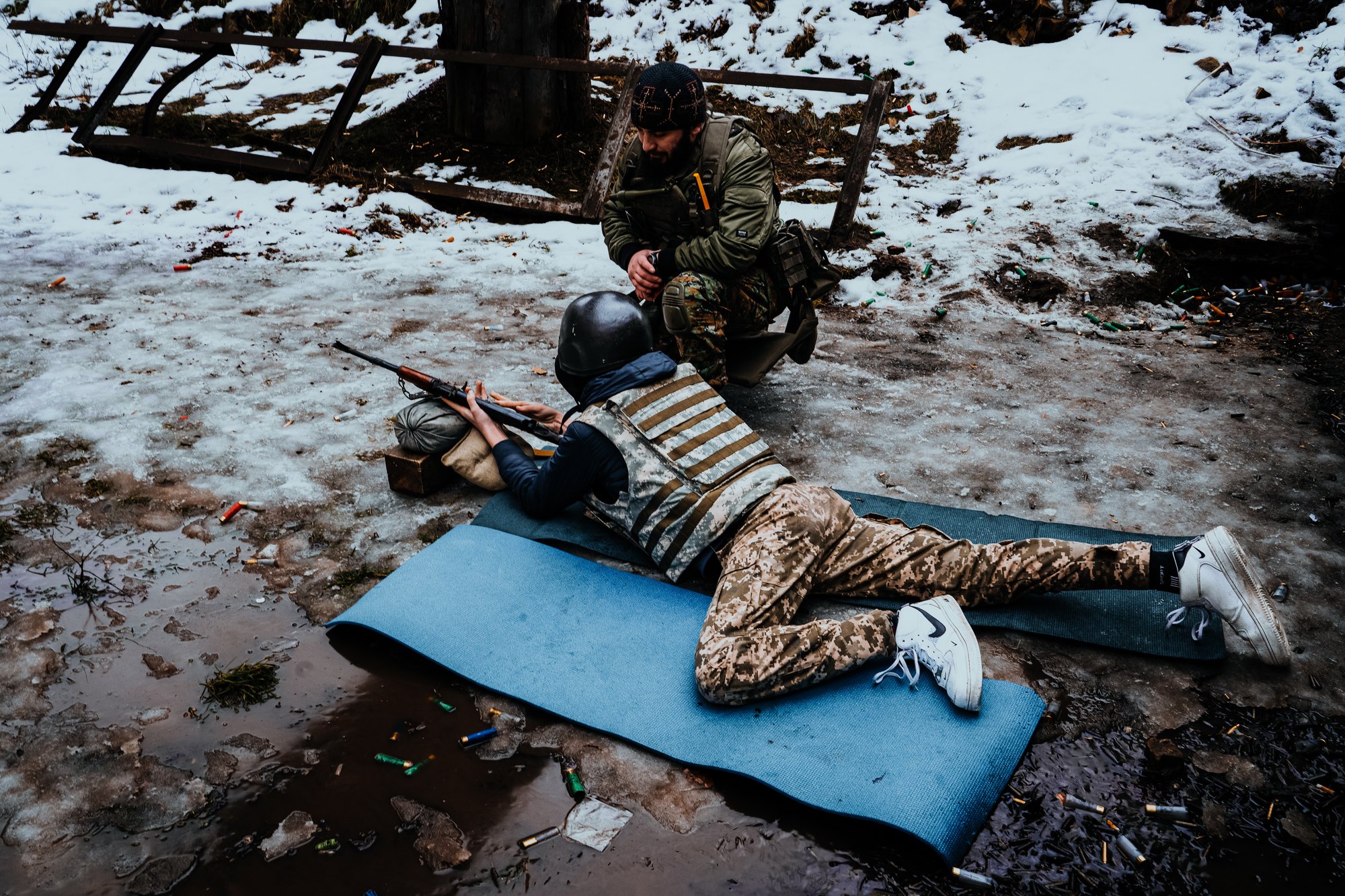
A Ukrainian civilian trains at a shooting range outside of Kyiv with the Georgian National Legion on Thursday, Feb. 10, 2022. Photo by Nolan Peterson/Coffee or Die.
Over the past year, the Russians have also tried to adapt and incorporate some tenets of mission command in their operations. Russian forces are now reportedly moving away from the battalion tactical group, which was their primary combined arms formation at the war’s outset.
According to a recent report by the Hudson Institute: “The once-vaunted [battalion tactical group] has failed to meet the requirements of large-scale operations in a prolonged interstate war, lacking the tactical flexibility and adaptive edge required for modern warfare.”
Thus, Russian military planners have devised a lighter, more flexible force generation pattern. Their new task force, named the “assault detachment,” comprises two or three companies and prioritizes tactical flexibility and freedom of movement in small-unit operations. This new formation mimics, in some ways, Wagner’s way of warfighting, which gives commanders greater flexibility to fight as they see fit and to find and exploit weak points.
Yet, the majority of Russia’s professional military was wiped out in the war’s opening months. Consequently, the Russians depend on ill-trained and unmotivated conscripts to fill their ranks. These troops are often press-ganged into service and drawn from a culture that does not value individual initiative and out-of-the-box thinking.
Russia’s soldiers are products of the civil society that produced them, and it is unrealistic to expect a new Russian recruit, who grew up in a police state, to demonstrate individual initiative and creativity on the battlefield. Thus, the Russians can try to reorganize their forces to become more flexible and adaptive, but, in my opinion, those changes won’t make a decisive difference on the battlefield.
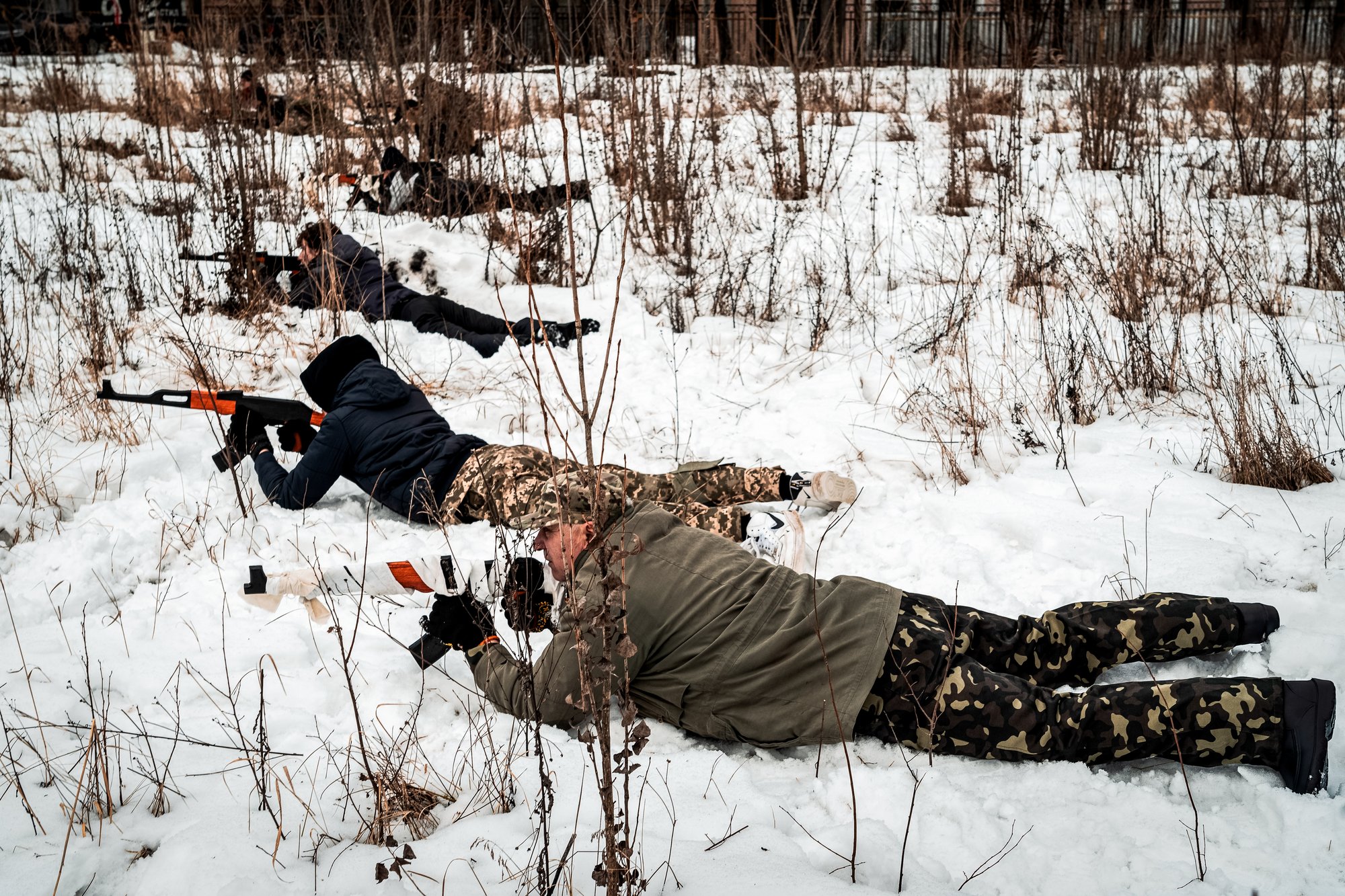
Civilian trainees participate in a military training course with the Georgian National Legion in Kyiv on Tuesday, Feb. 8, 2022. Photo by Nolan Peterson/Coffee or Die Magazine.
Non-Specialists
Another attribute of the typical Ukrainian soldier that I’d like to highlight is their general handiness, or “MacGyverness,” for lack of a better term. Most Ukrainians, even those with white-collar jobs, possess a wealth of practical knowledge and skills that exceed those of the average American.
In middle school, male Ukrainian students attend shop classes and learn basic auto mechanics. Female students take housekeeping classes, learning how to cook, sew, and other practical skills. In high school, Ukrainian students, both male and female, take classes in basic military skills, including marksmanship and first aid. Consequently, one of the greatest assets for Ukraine in this war has been its population’s baseline level of practical know-how.
These are people who can take care of themselves. They know how to survive on very little and work with what they have at hand. And that versatility applies to pilots, as well.
The early days of the war were nerve-wracking for Ukraine’s combat pilots — both in terms of the air war and the persistent threats faced on the ground between missions. Juice, the MiG-29 pilot, told me his home base was hit by missiles, airstrikes, and helicopter attacks — and they also faced the constant threat of raids by Russian special operations units. So, between combat sorties, Juice threw on a body armor vest and grabbed a gun to help defend his air base from the ground.
“It was something terrible, we had a lot of threats around the airfield,” he told me. “I was preparing for this, but I was still not ready.”
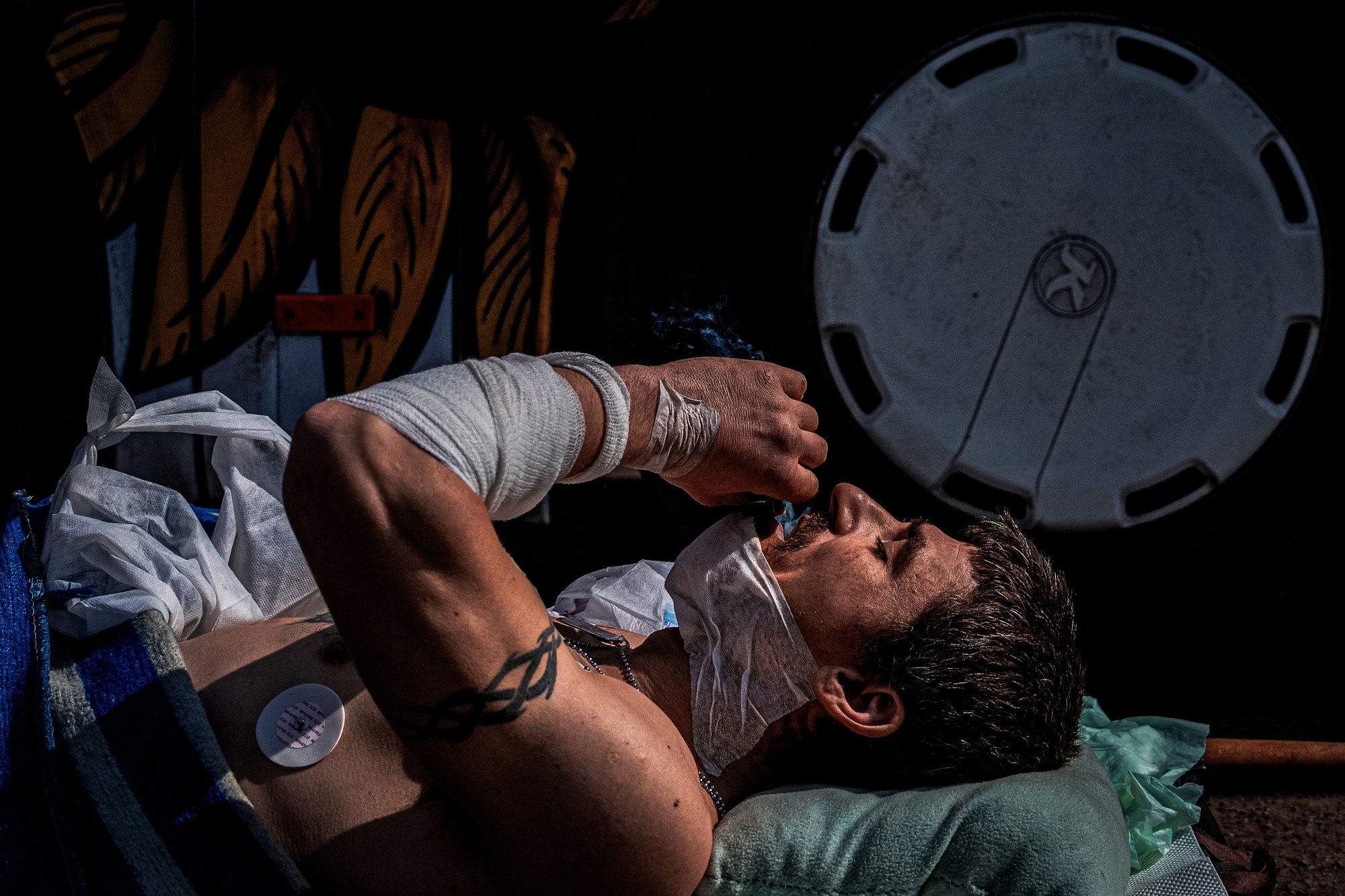
Oleksandr, an injured Ukrainian soldier, smokes a cigarette before evacuation by volunteers of the Hospitallers paramedic organization near a special medical bus in Donetsk region, Ukraine, Wednesday, March 22, 2023. AP photo by Evgeniy Maloletka.
Ukrainians also revealed their resilience and grit in less extraordinary ways.
For many, continuing their daily habits has become a form of resistance in itself. In between air raid alerts and missile attacks, people go shopping and to the gym. The restaurants and cafes are full, and children go to school. At the start of each school lesson, Ukrainian teachers now begin with a reminder of what to do during an air raid alert.
The closest parallel I can come up with is the stories I’ve read about London during the blitz in World War II. And how a quiet determination to go about normal routines loudly underscores a common commitment to victory.
In January, Tetiana Prohur, a 64-year-old who lives in Kyiv, told me:
“We are unbelievably scared during every attack, but we are holding on. If there is an attack, we go to the shelter, but we always come back to work. We need to support our country. We are all participants in this battle and resistance.”
Despite all my years of experience in war zones, I’d never experienced anything comparable to a sustained bombardment against an urban metropolis. Each time you go to the supermarket, to the gym, or to meet friends at a café, there’s this little part of you that wonders if you just sealed your fate. That is the wartime reality for millions of Ukrainians. But they carry on, and during every air raid alert or attack, you see little snippets of defiance in those underground spaces. In my apartment building’s bomb shelter, people have set up bean bag chairs, and they’ve left camping cots and blankets, as well as communal boxes of food and bottled water.
I spent New Year's Eve in a bomb shelter in Kyiv while Russia unleashed a massive missile and drone attack against the city. While the explosions thundered outside, a group of young people stood in the stairwell and took tequila shots, toasting “Glory to Ukraine” and “F— you, Putin.”
One of them told me, “This is our crazy new reality. Russia wants to ruin our lives, but we won’t let them.”
During power outages, the outdoor air raid sirens don’t work, so this winter, most people learned about air raid alerts from apps on their smartphones. Then, once underground in a bomb shelter, they would continually monitor a number of Telegram channels, which provide updates on the locations of incoming missiles or kamikaze drones.
Those updates often come from civilian observers who report sightings of inbound Russian strikes. And so, as we sit in the bomb shelters, we’re basically able to monitor the attacks in real time.

A Ukrainian soldier of the 28th brigade fires a rocket-propelled grenade on the frontline during a battle with Russian troops near Bakhmut, Donetsk region, Ukraine, Friday, March 24, 2023. AP photo by Libkos.
Sometimes, an air raid alert is sounded if Russian MiGs take off in Belarus, and there’s simply the threat of a Kinzhal, hypersonic missile attack, across all of Ukraine. In those cases, most people take the threat pretty casually, knowing that it’s not specifically targeted on their city or town. However, during a massive cruise missile or drone attack, the tension level rises as we read reports of sightings converging on Kyiv.
As the threats get closer and closer, we know that our city is the target. So we text friends and family, urging them to take this air raid alert seriously. Most people choose to stay underground until the attack is over and the all-clear is given.
These Telegram channels, and the spontaneous participation of the civilian observation networks that support them, are just another example of how enterprising Ukrainian civilians have come up with innovative solutions to their country’s security challenges.
In my estimation, the availability of smartphones and the constant stream of real-time, up-to-date information that Ukrainians are able to access during attacks has been a game-changer for the ability of civilians to preserve their morale and to carry on with their daily lives despite the constant air threats.

An impromptu New Year's party in a Kyiv bomb shelter during a Russian drone attack on Jan. 1, 2023. Photo by Nolan Peterson/Coffee or Die.
Information War
The resilience of Ukrainian civilians has kept their country in the fight, but Russia also knows that if Western civilian populations don’t support Ukraine’s cause, then those Western governments will no longer be able to sustain their lifeline of military assistance to Ukraine. With that in mind, it’s interesting to note that Russia’s social media manipulation and disinformation campaigns are generally geared toward the West, not toward undermining Ukrainian morale.
Russian propaganda has proved its power to manipulate millions of Americans into believing a fictitious version of the world that fits the Kremlin’s interests. The Russians are shaping the information space to their advantage, often using fake videos or images. Many of these concocted media have spread on American and European social media channels, feeding into narratives that threaten to undermine the bedrock of Western military support that is keeping Ukraine in the fight.
Our adversaries may not have the means to land armies on our shores, but they can attack our homeland. They can attack our utilities, our communications, and our means of mass transportation. And, by exploiting social media and novel technologies like AI and deep fakes, our adversaries can also manipulate our mindsets and turn us against each other with greater facility than any foes we’ve ever faced.

Japanese Prime Minister Fumio Kishida and Ukrainian President Volodymyr Zelenskyy, right, greet each other during their meeting in Kyiv, Ukraine, Tuesday, March 21, 2023. Ukrainian Presidential Press Office via AP.
Freedom Isn't Free
Nearly nine years ago, I first arrived in Ukraine. On that afternoon, the taxi from the airport dropped me off at the top of what was then known as Instituskaya Street, which is right off the Maidan — Kyiv’s central square and the epicenter of the 2014 revolution.
That day, workers were still replacing the road’s cobblestones that protesters had pulled up to build barricades against the pro-Russian regime’s snipers. The taxi deposited me at the spot where snipers had gunned down scores of Ukrainian protesters. The light poles and the sidewalk and the nearby trees were all pockmarked by bullet holes.
While I looked around and tried to appreciate what had happened there, I overheard one voice, spoken in accented English, that said, “Freedom isn’t free.”
We hear that expression a lot in America, but the past nine years in Ukraine have taught me what those words really mean.
The price of freedom is set by those who wish to destroy it. Yet, despite all that Russia has done, Ukrainians still believe that their freedom is worth fighting for — no matter what it costs. And these days, that’s a message the whole world needs to hear.
In his novel, For Whom The Bell Tolls, Ernest Hemingway wrote: “If we win here, we will win everywhere.”
I believe those words perfectly explain why Ukrainians deserve our unbending support.
Read Next: The Full-Scale War in Ukraine at One Year: A Reporter Looks Back

BRCC and Bad Moon Print Press team up for an exclusive, limited-edition T-shirt design!
BRCC partners with Team Room Design for an exclusive T-shirt release!
Thirty Seconds Out has partnered with BRCC for an exclusive shirt design invoking the God of Winter.
Lucas O'Hara of Grizzly Forge has teamed up with BRCC for a badass, exclusive Shirt Club T-shirt design featuring his most popular knife and tiomahawk.
Coffee or Die sits down with one of the graphic designers behind Black Rifle Coffee's signature look and vibe.
Biden will award the Medal of Honor to a Vietnam War Army helicopter pilot who risked his life to save a reconnaissance team from almost certain death.
Ever wonder how much Jack Mandaville would f*ck sh*t up if he went back in time? The American Revolution didn't even see him coming.
A nearly 200-year-old West Point time capsule that at first appeared to yield little more than dust contains hidden treasure, the US Military Academy said.












